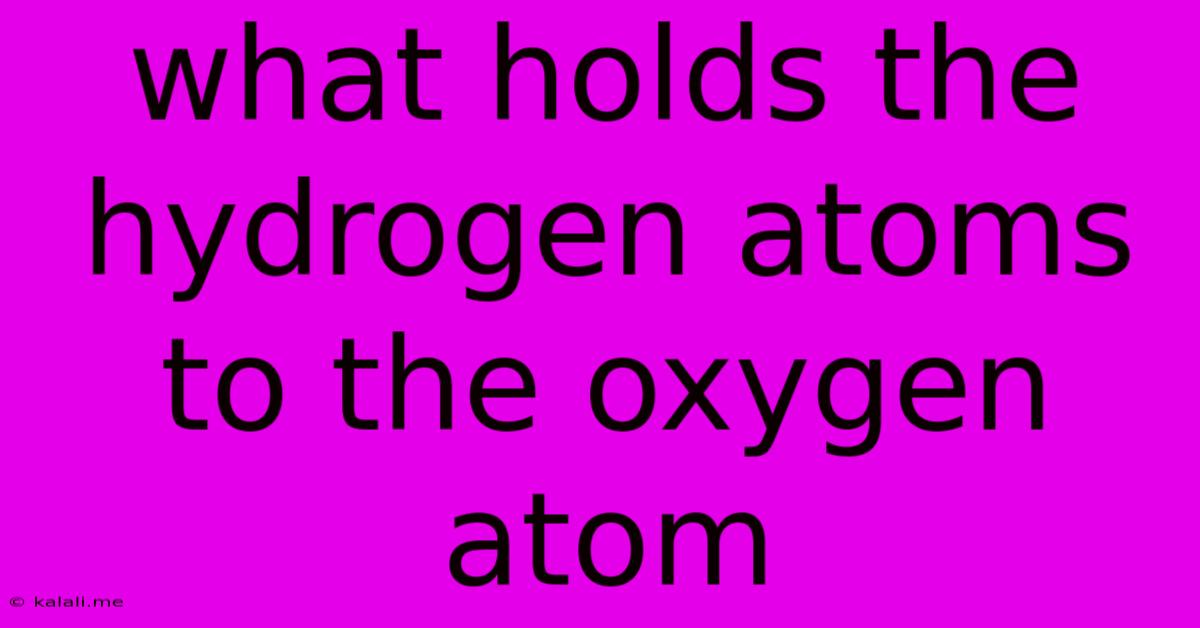What Holds The Hydrogen Atoms To The Oxygen Atom
Kalali
May 10, 2025 · 3 min read

Table of Contents
What Holds Hydrogen Atoms to Oxygen Atoms? Understanding Chemical Bonds in Water
Water, the elixir of life, is a simple molecule composed of two hydrogen atoms and one oxygen atom (H₂O). But what exactly holds these atoms together? The answer lies in the fascinating world of chemical bonds, specifically covalent bonds. This article will delve into the nature of these bonds and explore the forces that create the stable water molecule.
This article explains the fundamental forces that bind hydrogen and oxygen atoms in a water molecule, focusing on covalent bonds, electronegativity differences, and the resulting polar nature of the molecule. Understanding these concepts is key to grasping the unique properties of water.
The Role of Covalent Bonds
Atoms bond together to achieve a more stable electron configuration, often resembling that of a noble gas. Hydrogen, with one electron, needs one more to fill its valence shell. Oxygen, with six valence electrons, requires two more to complete its outer shell. This is where covalent bonding comes into play.
A covalent bond is formed when atoms share electrons to achieve a stable electron configuration. In a water molecule, each hydrogen atom shares one electron with the oxygen atom, and the oxygen atom shares one electron with each hydrogen atom. This sharing creates a shared electron pair between each hydrogen and oxygen atom, resulting in two covalent bonds. These shared electrons are attracted to the positively charged nuclei of both the hydrogen and oxygen atoms, holding the atoms together.
Electronegativity: The Unequal Sharing
While the electrons are shared, the sharing isn't perfectly equal. Oxygen is significantly more electronegative than hydrogen. Electronegativity refers to an atom's ability to attract electrons in a chemical bond. Because oxygen is more electronegative, it pulls the shared electrons closer to its nucleus than the hydrogen atoms do. This creates a slight negative charge (δ-) around the oxygen atom and a slight positive charge (δ+) around each hydrogen atom.
Polarity and Hydrogen Bonding
This unequal sharing of electrons results in a polar covalent bond. The water molecule possesses a slightly negative end (the oxygen atom) and two slightly positive ends (the hydrogen atoms). This polarity is crucial for many of water's unique properties, such as its high boiling point, surface tension, and ability to act as a solvent. The slightly positive hydrogen atoms of one water molecule are attracted to the slightly negative oxygen atoms of other water molecules. This attraction is called a hydrogen bond, a weaker type of bond than a covalent bond, but still significant in influencing the behavior of water.
Summary: A Stable Partnership
In conclusion, the hydrogen atoms are held to the oxygen atom in a water molecule primarily through covalent bonds, formed by the sharing of electrons. However, the unequal sharing of these electrons due to the difference in electronegativity between oxygen and hydrogen creates a polar molecule with slightly positive and negative regions. These polar regions allow for the formation of hydrogen bonds between water molecules, further contributing to water's unique and essential properties. Understanding this fundamental chemical bonding is key to appreciating the remarkable nature of water.
Latest Posts
Latest Posts
-
Jaguar Adaptations In The Tropical Rainforest
May 10, 2025
-
How To Find Average Velocity From Velocity Time Graph
May 10, 2025
-
What Is Non Living Things In The Ecosystem
May 10, 2025
-
How Many Fl Oz In 6 Cups
May 10, 2025
-
What Is 1 Percent Of 5000
May 10, 2025
Related Post
Thank you for visiting our website which covers about What Holds The Hydrogen Atoms To The Oxygen Atom . We hope the information provided has been useful to you. Feel free to contact us if you have any questions or need further assistance. See you next time and don't miss to bookmark.